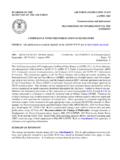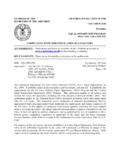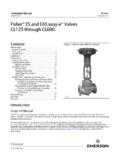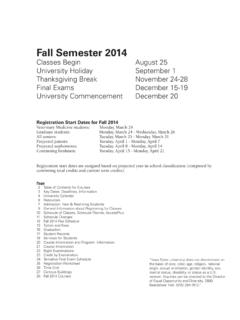Transcription of BY ORDER OF THE SECRETARY AIR FORCE INSTRUCTION 33 …
1 BY ORDER OF THE SECRETARY OF THE AIR FORCE AIR FORCE INSTRUCTION 33-115 16 SEPTEMBER 2014 YOKOTA AIR BASE Supplement 6 MAY 2015 Communications and Information AIR FORCE INFORMATION TECHNOLOGY (IT) SERVICE MANAGEMENT COMPLIANCE WITH THIS PUBLICATION IS MANDATORY ACCESSIBILITY: Publications and forms are available for downloading or ordering on the e-Publishing website at RELEASABILITY: There are no releasability restrictions on this publication. OPR: SAF/A6CS Supersedes: AFI33-115V1, 24 May 2006, AFI33-115V2, 14 April 2004, AFI33-115 V3, 15 April 2004, AFI33-129, 3 February 2005,AFI33-138, 28 November 2005 Certified by: SAF/A6C (Maj Gen Earl Matthews) Pages: 49 (YOKOTAAB) OPR: 374 CS/SCOO Certified by: 374 MSG/CC (Col Scott P. Maskery) Pages:2 This Air FORCE INSTRUCTION (AFI) defines AF IT Service Management and assigns responsibilities for standardization and management of IT Services in the AF.
2 This INSTRUCTION implements AF Policy Directive (AFPD) 33-1, Cyberspace Support, Department of Defense (DoD) INSTRUCTION (DoDI) , Internet Domain Name Use and Approval, DoDI , NetOps for the Global Information Grid (GIG), DoDI , Network Management (NM) and DoDI , DoD Internet Services and Internet-Based Capabilities. This INSTRUCTION is consistent with AFPD 33-2, Information Assurance (IA) Program; AFPD 33-3, Information Management; AFPD 33-4, Information Technology Governance; and AFPD 10-17, Cyberspace Operations. This INSTRUCTION provides guidance, direction and assigns responsibilities for the Air FORCE Information Networks (AFIN) as the Air FORCE provisioned portion of the DoD Information 2 AFI33-115 _YOKOTAABSUP_I 6 MAY 2015 Networks (DoDIN). This directive applies to all military and civilian Air FORCE personnel, the Air FORCE Reserve (AFR), and Air National Guard (ANG).
3 This publication shall be applied to contractors or other persons through the contract or other legally binding agreement with the Department of the Air FORCE . The authorities to waive wing/unit level requirements in this publication are identified with a Tier ( T-0, T-1, T-2, T-3 ) number following the compliance statement. See AFI 33-360, Publications and Forms Management, Table for a description of the authorities associated with the Tier numbers. Submit requests for waivers through the chain of command to the appropriate Tier waiver approval authority, or alternately, to the Publication OPR for non-tiered compliance items. Send recommended changes or comments to the Air FORCE Cyberspace Strategy & Policy Division (SAF/A6CS) using AF Form 847, Recommendation for Change of Publication.
4 Ensure that all records created as a result of processes prescribed in this publication are maintained in accordance with (IAW) Air FORCE Manual (AFMAN) 33-363, Management of Records, and disposed of in accordance with Air FORCE Records Information Management System (AFRIMS) Records Disposition Schedule (RDS). See Attachment 1 for a glossary of references and supporting information. (YOKOTAAB) Air FORCE INSTRUCTION (AFI) 33-115, 16 September 2014, is supplemented as follows. This supplement applies to all assigned, attached, and tenant units supported by AFNET and Yokota Air Base (AB), and separate operating locations supported by AFNET and Yokota AB. Refer recommended changes and questions about this publication to the Office of Primary Responsibility (OPR) using the AF Form 847, Recommendation for Change of Publication; route AF Form 847s from the field through the appropriate functional s chain of command.
5 Ensure that all records created as a result of processes prescribed in this publication are maintained in accordance with (IAW) Air FORCE Manual (AFMAN) 33-363, Management of Records, and disposed of IAW Air FORCE Records Disposition Schedule (RDS) located in the Air FORCE Records Information Management System (AFRIMS) located at SUMMARY OF CHANGES This is a total revision of AFI 33-115. Information from AFI 33-115 Volume 1, Network Operations, AFI 33-115 Volume 2, Licensing Network Users and Certifying Network Professionals, AFI 33-115 Volume 3, Air FORCE Network Operating instructions , AFI 33-129, Web Management and Internet, and AFI 33-138, Enterprise Network Operations Notification and Tracking, were incorporated in this document. AFMAN 33-152, User Responsibilities and Guidance for Information Systems, provides guidance for responsible use of the Internet that was previously covered by AFI 33-129 and user certification requirements previously covered by AFI 33-115V2.
6 Network professional certification requirements are covered by AFMAN 33-285, Information Assurance (IA) Workforce Improvement Program. Methods and Procedures Technical ORDER (MPTO) 00-33A-1109, Vulnerability Management, provides vulnerability notification and tracking processes and procedures previously covered by AFI 33-138. AFPD 10-17, Cyberspace Operations, and supporting AFIs, provides AF policy and assigns responsibility for the planning and execution of Cyberspace Operations including DoDIN AFI33-115 _YOKOTAABSUP_I 6 MAY 2015 3 Operations. AFI 10-1701, Command and Control (C2) of Cyberspace, provides Command and Control (C2) guidance for DoDIN Operations within the AF. 1. Purpose.. 3 2. Objectives.. 3 3. Background.. 4 Figure 1. Information Environment Relationships.
7 5 4. Roles and Responsibilities.. 6 5. AF IT Services Framework.. 22 Figure 2. AF IT Services Framework.. 23 6. AFIN Baseline Management.. 32 7. Operation of AF IT Services within the AFIN.. 33 Attachment 1 GLOSSARY OF REFERENCES AND SUPPORTING INFORMATION 39 1. Purpose. This INSTRUCTION defines AF IT Service Management and assigns responsibilities for the configuration, provisioning, maintenance, and management of AFIN using an IT Service Management (ITSM) framework to further integrate capabilities and maintain configuration control of AF networks and data servers. This INSTRUCTION serves as the single reference for AF IT Service Management policy and applies to all personnel who manage, configure, operate, maintain, defend, or extend any portion of the AFIN or provide support within the AF for the DoDIN and the Joint Information Environment (JIE).
8 Procedural guidance supporting this AFI is contained in Methods and Procedures Technical Orders (MPTOs) directing standard processes for management, standardization, and maintenance of AF IT Services applicable to all AF personnel, see paragraph Cyberspace operational orders as defined in AFI 10-1701 ( , AF Cyber Tasking Orders, Cyber Control Orders, AF Time Compliance Network Orders) shall take precedence over information contained in this AFI and supporting MPTOs if there is a conflict. 2. Objectives. The primary objective of this AFI is to establish and define AF IT Service Management with roles and responsibilities to ensure the AFIN is designed, built, configured, secured, operated, maintained, and sustained to meet mission requirements. This AFI also provides guidance regarding migration of AF enterprise capabilities (core services, applications, and systems) to the JIE according to DoD guidance.
9 AF IT Service Management integrates, secures, and manages the AFNET/AFNET-S with processes and capabilities to enable the seamless, secure, and reliable exchange of information across the AFIN and the DoDIN. The AFNET is the AF s underlying unclassified network that enables AF operational capabilities and lines of business. AFNET-S is the secure AFNET. This AFI and supporting 00-33 series MPTOs shall not alter or supersede the existing authorities and policies of the Director of National Intelligence (DNI) regarding the protection of Sensitive Compartmented Information (SCI) systems or intelligence, surveillance, reconnaissance mission and mission support systems or higher authoritative 4 AFI33-115 _YOKOTAABSUP_I 6 MAY 2015 guidance governing Special Access Program (SAP) systems.
10 When DNI or SAP authorities fail to address areas covered by this AFI, this AFI and associated MPTOs will be followed. If there is conflict between this AFI and associated MPTOs with guidance issued by DNI or SAP authorities, DNI or SAP guidance will take precedence. For this INSTRUCTION , the term Major Command (MAJCOM) also applies to Numbered Air FORCE (NAF), Field Operating Agency (FOA) and Direct Reporting Unit (DRU) when not assigned to a MAJCOM. All AF organizations will follow this policy when extending AF IT Services. 3. Background. The AF Information Environment consists of AF unique information capabilities across the IT Governance Mission Areas: Business (BMA), Warfighting (WMA), Defense Intelligence (DIMA) and Information Environment (IEMA). The AF Information Environment includes the IT systems, components and networks of the Defense Business Systems, National Security Systems (NSS), Platform IT, Enterprise Core Services and Common Computing Environments as depicted in Figure 1.















